INSTITUT SUPERIEUR D'ANTHROPOLOGIE
INSTITUTE OF ANTHROPOLOGY
ONLINE COURSES / COURS A DISTANCE
FALL TERM : OCTOBER 2015
REGISTER NOW
IRLANDE – 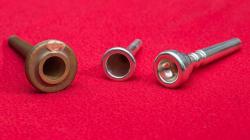 Navan - An Australian archaeologist has now been able to put 3D printing to use to rock the world of ancient history, offering up one of those surprises that comes along every now and then to show us that all things are not always as they seem. This can be even more jarring when experts have been under one impression for quite some time, as was the case with the Conical Spear Butt of Navan–an Irish artifact found in the 1900s and thought obviously to be a weapon and tool. With the availability of digital design and 3D printing, Canberra archaeologist Billy Ó Foghlú wasn’t restricted to the two dimensional world for trying out and demonstrating his theory that the spear butt, crafted between 100BC and 200AD, was actually part of a musical instrument instead. He was able to play around with a variety of ideas and take it upon himself to have a replica of the artifact 3D printed for experimentation and testing purposes–not quite so possible with an actual artifact we are working hard to preserve. Not only did they recreate the so-called spear butt, Ó Foghlú and a 3D printing service provider in Sydney came up with the idea to cast the mouthpiece in bronze, giving it even more of an authentic appeal–and even allowing him to play a tune as he turned it into the mouthpiece it was meant to be. With his 3D printed replica, Ó Foghlú is able to show us all, that indeed, it would seem humans were making music in the Bronze Age too. The artifact is not actually an instrument in itself but is a mouthpiece that would have been used to enhance the sound of a horn. “These horns were not just hunting horns or noisemakers. They were very carefully constructed and repaired, they were played for hours. Music clearly had a very significant role in the culture,” he said.
Navan - An Australian archaeologist has now been able to put 3D printing to use to rock the world of ancient history, offering up one of those surprises that comes along every now and then to show us that all things are not always as they seem. This can be even more jarring when experts have been under one impression for quite some time, as was the case with the Conical Spear Butt of Navan–an Irish artifact found in the 1900s and thought obviously to be a weapon and tool. With the availability of digital design and 3D printing, Canberra archaeologist Billy Ó Foghlú wasn’t restricted to the two dimensional world for trying out and demonstrating his theory that the spear butt, crafted between 100BC and 200AD, was actually part of a musical instrument instead. He was able to play around with a variety of ideas and take it upon himself to have a replica of the artifact 3D printed for experimentation and testing purposes–not quite so possible with an actual artifact we are working hard to preserve. Not only did they recreate the so-called spear butt, Ó Foghlú and a 3D printing service provider in Sydney came up with the idea to cast the mouthpiece in bronze, giving it even more of an authentic appeal–and even allowing him to play a tune as he turned it into the mouthpiece it was meant to be. With his 3D printed replica, Ó Foghlú is able to show us all, that indeed, it would seem humans were making music in the Bronze Age too. The artifact is not actually an instrument in itself but is a mouthpiece that would have been used to enhance the sound of a horn. “These horns were not just hunting horns or noisemakers. They were very carefully constructed and repaired, they were played for hours. Music clearly had a very significant role in the culture,” he said.
http://3dprint.com/93137/3d-printed-artifact/
ROYAUME UNI – 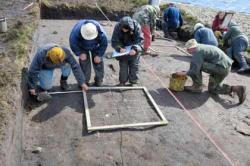 North Pennines - Archaeologists excited by a crowd of stones sticking out of eroding peat at a County Durham nature reserve say they have retrieved 1,500 pieces of a Stone Age campsite, ranging from Mesolithic objects to industrial waste flakes. Bands of hunter gatherers are thought to have occupied the hunting camp for days at a time, fishing, foraging for berries and nuts and pursuing wild cattle and deer from about 7,000 BC – three or four millennia before the land was farmed. “The finds date back to the Mesolithic period, which is the earliest period for which we have evidence for people in the North Pennines. Most of the pieces are very small and include chert, which is a locally found stone, and flint that has probably come from Yorkshire. “Unfortunately no structures like houses or wigwams were found, but it was very interesting nonetheless. And it gives us an insight into what life was like in Upper Teesdale and for the first people who lived here after the end of the Ice Age, perhaps 300 generations ago.”
North Pennines - Archaeologists excited by a crowd of stones sticking out of eroding peat at a County Durham nature reserve say they have retrieved 1,500 pieces of a Stone Age campsite, ranging from Mesolithic objects to industrial waste flakes. Bands of hunter gatherers are thought to have occupied the hunting camp for days at a time, fishing, foraging for berries and nuts and pursuing wild cattle and deer from about 7,000 BC – three or four millennia before the land was farmed. “The finds date back to the Mesolithic period, which is the earliest period for which we have evidence for people in the North Pennines. Most of the pieces are very small and include chert, which is a locally found stone, and flint that has probably come from Yorkshire. “Unfortunately no structures like houses or wigwams were found, but it was very interesting nonetheless. And it gives us an insight into what life was like in Upper Teesdale and for the first people who lived here after the end of the Ice Age, perhaps 300 generations ago.”
http://www.culture24.org.uk/history-and-heritage/archaeology/art535278-archaeologists-find-stone-age-campsite-hunters-fished-foraged-teesside
ISRAEL –  Jerusalem - A mysterious pyramid-shaped flight of stairs dating to the time of Jesus, has been unearthed in ancient Jerusalem, the Israel Antiquities Authority (IAA) announced. Made from large ashlar — or finely cut — stones, the 2,000-year-old stepped structure leads to a podium. The puzzling staircase was found alongside a stepped street that once led Jewish pilgrims from the rock cut Pool of Siloama on the southern slope of the City of David to the Second Temple which stood atop the Temple Mount. Consisting of enormous stone slabs, the street was built sometime in the fourth decade of the 1st century A.D. and was one of the largest construction projects undertaken in Jerusalem during the Second Temple period. The Second temple era, running from 538 B.C. to 70 A.D., refers to the lifetime of the temple built by King Herod the Great to replace the First Temple, razed by the Babylonians around 587 B.C. In 70 A.D., the Second Temple also vanished as the Romans sacked the city and plundered Herod’s magnificent white and gold temple. Then they paraded the treasure, which also helped finance the building of the Colosseum, through the streets of Rome in triumph. Archaeologists do not know yet what the pyramid-shaped staircase was used for. Rabbinic texts refer to stone platforms used for auctions or as “Stone of Claims” to find lost belongings, but nothing like that structure has been found in Jerusalem or elsewhere in ancient Israel. Intriguingly, dozens of whole pottery vessels, stone vessels and glassware were found at its foot. Since the structure is built along the street in a place that is clearly visible from afar by passers-by making their way to the Temple, the archaeologist speculate it was a kind of monumental podium that attracted the public’s attention when walking on the city’s main street.
Jerusalem - A mysterious pyramid-shaped flight of stairs dating to the time of Jesus, has been unearthed in ancient Jerusalem, the Israel Antiquities Authority (IAA) announced. Made from large ashlar — or finely cut — stones, the 2,000-year-old stepped structure leads to a podium. The puzzling staircase was found alongside a stepped street that once led Jewish pilgrims from the rock cut Pool of Siloama on the southern slope of the City of David to the Second Temple which stood atop the Temple Mount. Consisting of enormous stone slabs, the street was built sometime in the fourth decade of the 1st century A.D. and was one of the largest construction projects undertaken in Jerusalem during the Second Temple period. The Second temple era, running from 538 B.C. to 70 A.D., refers to the lifetime of the temple built by King Herod the Great to replace the First Temple, razed by the Babylonians around 587 B.C. In 70 A.D., the Second Temple also vanished as the Romans sacked the city and plundered Herod’s magnificent white and gold temple. Then they paraded the treasure, which also helped finance the building of the Colosseum, through the streets of Rome in triumph. Archaeologists do not know yet what the pyramid-shaped staircase was used for. Rabbinic texts refer to stone platforms used for auctions or as “Stone of Claims” to find lost belongings, but nothing like that structure has been found in Jerusalem or elsewhere in ancient Israel. Intriguingly, dozens of whole pottery vessels, stone vessels and glassware were found at its foot. Since the structure is built along the street in a place that is clearly visible from afar by passers-by making their way to the Temple, the archaeologist speculate it was a kind of monumental podium that attracted the public’s attention when walking on the city’s main street.
http://news.discovery.com/history/archaeology/mysterious-2000-year-old-podium-found-in-jerusalem-150901.htm
BULGARIE – 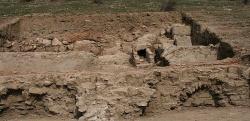 Heraclea Sintica - Archaeologists discovered a town hall in the ancient Greek city of Heraclea Sintica near the town of Petrich in southwestern Bulgaria. The find represents a unique and large public building dating back to the early Hellenistic period, 3rd-4th century BC, and has been in place since the foundation of the settlement. As it was composed of large blocks, which were carefully and specially treated, this was not an ordinary building and was most probably part of the northern end of the agora. It could have been the seat of the ruler of the settlement or the building where the council of the elders gathered. According to archaeologists, this is one of the few valuable and sizable finds from the early Hellenistic period in Bulgaria. Archaeologists established that two fires had raged at the site, the first one dating back to the second half of the 4th century BC during the flight of local tribes from invaders. A thick layer of clay was put and a new building was erected on the same site, but a hundred years later, a second fire raged in the second half of the 3rd century BC. Archaeologist are working to reinforce the site in order to prevent it from getting covered by collapsing upper layers. Last year, the archaeologists discovered two shops dating back to 3rd-5th century AD, which were located in the northern part of the Roman forum, where many coins and archaeological details were found. Among the finds were marble and ceramic decorations as well as theatrical masks, which were most likely sold in the shops. Terracotta figures and masks, stone figurines, lamps, coins, moulds, fibulae, cups and plates as well as a votive tablet depicting the face of the goddess of divine retribution Nemesis, were among the finds. Also different armaments, such as arrows and leaden weights used with slings, were found at the site. The finds are dating back to the period between 4th century BC to 5th century AD. The town was founded by the ancient Macedon leader Cassander around 300 BC and was inhabited by the Thracian tribe of the Sintians.
Heraclea Sintica - Archaeologists discovered a town hall in the ancient Greek city of Heraclea Sintica near the town of Petrich in southwestern Bulgaria. The find represents a unique and large public building dating back to the early Hellenistic period, 3rd-4th century BC, and has been in place since the foundation of the settlement. As it was composed of large blocks, which were carefully and specially treated, this was not an ordinary building and was most probably part of the northern end of the agora. It could have been the seat of the ruler of the settlement or the building where the council of the elders gathered. According to archaeologists, this is one of the few valuable and sizable finds from the early Hellenistic period in Bulgaria. Archaeologists established that two fires had raged at the site, the first one dating back to the second half of the 4th century BC during the flight of local tribes from invaders. A thick layer of clay was put and a new building was erected on the same site, but a hundred years later, a second fire raged in the second half of the 3rd century BC. Archaeologist are working to reinforce the site in order to prevent it from getting covered by collapsing upper layers. Last year, the archaeologists discovered two shops dating back to 3rd-5th century AD, which were located in the northern part of the Roman forum, where many coins and archaeological details were found. Among the finds were marble and ceramic decorations as well as theatrical masks, which were most likely sold in the shops. Terracotta figures and masks, stone figurines, lamps, coins, moulds, fibulae, cups and plates as well as a votive tablet depicting the face of the goddess of divine retribution Nemesis, were among the finds. Also different armaments, such as arrows and leaden weights used with slings, were found at the site. The finds are dating back to the period between 4th century BC to 5th century AD. The town was founded by the ancient Macedon leader Cassander around 300 BC and was inhabited by the Thracian tribe of the Sintians.
http://www.novinite.com/articles/170621/Bulgarian+Archaeologists+Discover+Ancient+Town+Hall+near+Petrich
BULGARIE – 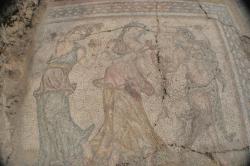 Augusta Traiana - The Regional Museum of History in the southern Bulgarian city of Stara Zagora has unveiled for the first time a restored 4th century AD mosaic found in the ruins of the Ancient Roman city Augusta Traiana which depicts a “Dionysus’s Procession”. The Dionysus’s Procession mosaic has been shown to the media and the public at a special ceremony in the Stara Zagora Regional Museum of History, four years after its discovery in Augusta Traianaback in 2011 because of its really complex and time-consuming restoration, reports the website of theStara Zagora District Governor. The mosaic does not show ancient god Dionysus himself but, rather, part of his entourage including some of the participants in his Bacchanalia: Silenus, who, according to Ancient Greek mythology, was a tutor and companion of Dionysus, leading two dancing women, or “bacchantes” (i.e. followers ofBacchus (Dionysus)). The Dyonysus’s Procession mosaic was found during rescue archaeological excavations in the northern part of the Ancient Roman city of Augusta Traiana, close to its fortress wall.
Augusta Traiana - The Regional Museum of History in the southern Bulgarian city of Stara Zagora has unveiled for the first time a restored 4th century AD mosaic found in the ruins of the Ancient Roman city Augusta Traiana which depicts a “Dionysus’s Procession”. The Dionysus’s Procession mosaic has been shown to the media and the public at a special ceremony in the Stara Zagora Regional Museum of History, four years after its discovery in Augusta Traianaback in 2011 because of its really complex and time-consuming restoration, reports the website of theStara Zagora District Governor. The mosaic does not show ancient god Dionysus himself but, rather, part of his entourage including some of the participants in his Bacchanalia: Silenus, who, according to Ancient Greek mythology, was a tutor and companion of Dionysus, leading two dancing women, or “bacchantes” (i.e. followers ofBacchus (Dionysus)). The Dyonysus’s Procession mosaic was found during rescue archaeological excavations in the northern part of the Ancient Roman city of Augusta Traiana, close to its fortress wall.
http://archaeologyinbulgaria.com/2015/08/27/bulgarias-stara-zagora-unveils-restored-ancient-mosaics-from-roman-city-augusta-traiana-showing-silenus-with-bacchantes/
INDE – 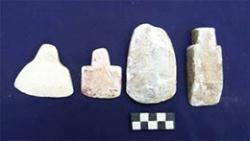 Hatishila-Bogoribari - In a significant development, a resident of the Hatishila-Bogoribari village under Sonapur Revenue Circle of Kamrup (Metro) has discovered some stone implements belonging to the Neolithic Age, also called New Stone Age. The resident, Moon Talukdar, discovered the stone implements at his kitchen garden while preparing the soil for the seasonal cultivation. The tools were discovered a few weeks back. In all, five stone implements were collected from the site by Talukdar, among which four are definitely Neolithic celts. Among these Neolithic tools, one is a bar-type shoulder adze, while the second one is a typical shoulder axe, the third one is triangular axe and the fourth one is a common Neolithic axe, said the State Archaeology Directorate in a statement here. The statement of the Archaeology Directorate said, apart from stone artifacts, a good number of potsherds were found scattered in a courtyard of another resident of the same village, at a distance of only 15 meters from the Neolithic site. The potsherds include rim, led, base of pot with crisscross, chord impression, parallel lines, etc, which are hand-made as well as wheel-turned varieties, the statement said.
Hatishila-Bogoribari - In a significant development, a resident of the Hatishila-Bogoribari village under Sonapur Revenue Circle of Kamrup (Metro) has discovered some stone implements belonging to the Neolithic Age, also called New Stone Age. The resident, Moon Talukdar, discovered the stone implements at his kitchen garden while preparing the soil for the seasonal cultivation. The tools were discovered a few weeks back. In all, five stone implements were collected from the site by Talukdar, among which four are definitely Neolithic celts. Among these Neolithic tools, one is a bar-type shoulder adze, while the second one is a typical shoulder axe, the third one is triangular axe and the fourth one is a common Neolithic axe, said the State Archaeology Directorate in a statement here. The statement of the Archaeology Directorate said, apart from stone artifacts, a good number of potsherds were found scattered in a courtyard of another resident of the same village, at a distance of only 15 meters from the Neolithic site. The potsherds include rim, led, base of pot with crisscross, chord impression, parallel lines, etc, which are hand-made as well as wheel-turned varieties, the statement said.
http://www.assamtribune.com/scripts/detailsnew.asp?id=sep0115/city052
FRANCE – 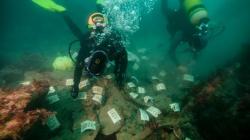 Batz - Au large de Roscoff, un bateau de recherche archéologique subaquatique remonte des tonnes de lingots d'étain. Ils proviennent d'une épave romaine vieille de milliers d'années. Des tonnes de lingots d’étain, près d’une épave romaine… Depuis quelques jours, à l’est de l’Île de Batz, au large de Roscoff (Finistère), une équipe de plongeurs et d’archéologues étiquette et remonte ces paquets de la mer. « Un navire de commerce romain semble y avoir tapé la roche puis s’être ouvert en deux », éclaire Olivia Hulot, responsable de la façade Bretagne au département des recherches archéologiques subaquatiques et sous-marines. « Nous avons découvert de l’étain, sans valeur commerciale, ainsi que de la céramique romaine ! » Le naufrage remonterait au IIIe ou au IVe siècle. La trouvaille, faite par un plongeur de la région, pourrait constituer un témoignage « majeur de la production et du transport de l’étain depuis les filons finistériens », selon l’archéologue. Finistériens forcément, car il n’existe pas de filon d’étain dans le pourtour méditerranéen. Des chercheurs du CNRS travaillent également sur les objets remontés de l’épave. La reconstitution en 3D, à l’aide de photographies sous-marines, devrait prendre un mois.
Batz - Au large de Roscoff, un bateau de recherche archéologique subaquatique remonte des tonnes de lingots d'étain. Ils proviennent d'une épave romaine vieille de milliers d'années. Des tonnes de lingots d’étain, près d’une épave romaine… Depuis quelques jours, à l’est de l’Île de Batz, au large de Roscoff (Finistère), une équipe de plongeurs et d’archéologues étiquette et remonte ces paquets de la mer. « Un navire de commerce romain semble y avoir tapé la roche puis s’être ouvert en deux », éclaire Olivia Hulot, responsable de la façade Bretagne au département des recherches archéologiques subaquatiques et sous-marines. « Nous avons découvert de l’étain, sans valeur commerciale, ainsi que de la céramique romaine ! » Le naufrage remonterait au IIIe ou au IVe siècle. La trouvaille, faite par un plongeur de la région, pourrait constituer un témoignage « majeur de la production et du transport de l’étain depuis les filons finistériens », selon l’archéologue. Finistériens forcément, car il n’existe pas de filon d’étain dans le pourtour méditerranéen. Des chercheurs du CNRS travaillent également sur les objets remontés de l’épave. La reconstitution en 3D, à l’aide de photographies sous-marines, devrait prendre un mois.
http://www.ouest-france.fr/archeologie-decouverte-de-lingots-au-large-de-lile-de-batz-3643909
FRANCE – 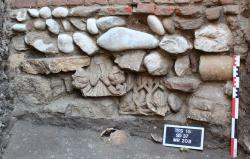 Toulouse - Les fouilles qui ont eu lieu pour établir un diagnostic archéologique sur la place Saint-Sernin continue de révéler des trésors. Achevées le 5 août dernier, les services archéologiques de la ville viennent de communiquer des résultats exceptionnels. En effet, les fouilles ont mis au jour deux chapiteaux romans datés du début du XIIe siècle, incrustés dans les fondations d’un mur datant lui du XIXe. Jugée plutôt rare, cette découverte est d’autant plus exceptionnelle que « les pièces mises au jour sont dans un très bon état de conservation », indique Toulouse Métropole.
Toulouse - Les fouilles qui ont eu lieu pour établir un diagnostic archéologique sur la place Saint-Sernin continue de révéler des trésors. Achevées le 5 août dernier, les services archéologiques de la ville viennent de communiquer des résultats exceptionnels. En effet, les fouilles ont mis au jour deux chapiteaux romans datés du début du XIIe siècle, incrustés dans les fondations d’un mur datant lui du XIXe. Jugée plutôt rare, cette découverte est d’autant plus exceptionnelle que « les pièces mises au jour sont dans un très bon état de conservation », indique Toulouse Métropole.
http://actu.cotetoulouse.fr/patrimoine-de-nouveaux-vestiges-exceptionnels-retrouves-place-saint-sernin_18162/